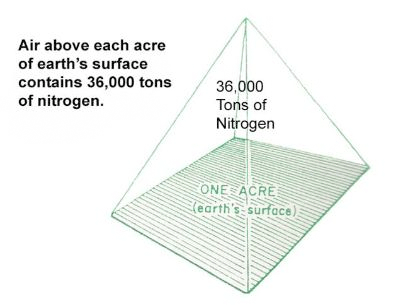Nitrogen
Nitrogen
Why do we buy so much nitrogen?
When nature has supplied us “free” nitrogen from the air (78%N), legume crops to supplement our soil, & priceless nitrogen-fixing (Azotobacter) bacteria, why do American farmers buy so much nitrogen fertilizer?
he ability to transform the chemically stable gas nitrogen, into organic nitrogen compounds is found in only a few groups of microorganisms. The most important to agriculture are the bacteria, which include both aerobic and anaerobic species, most of which are common in the environment and live in soil independently of plants. The best known of these free-living bacteria are the aerobic AZOTOBACTER and the anaerobic CLOSTRIDIUM. These bacteria grow best when there are carbohydrates, which can come from organic matter (manures and crop residues), added to the soil as a source of food. When large quantities of carbohydrates, are incorporated into soil, significant increases in combined nitrogen occur.
The best known nitrogen fixing microorganisms is RHIZOBIUM, THE TYPE OF SYMBIOTIC BACTERIA WHICH GROWS IN THE ROOT OF LEGUMES, SUCH AS ALFALFA, CLOVER, BEANS, AND PEAS. Neither the legumes nor the bacteria alone can fix nitrogen, only when they “cooperate” can this be done. The formation of root nodules is amazing. A healthy nodule will have a pink or red color inside because of a red protein cited leghemoglobin, which is similar to the red hemoglobin that carries oxygen in our blood. The RHIZOBIUII bacteria can survive in the soil for many years, waiting to reinfect new legumes, if soil conditions are favorable Needless to say; anything farmers add to their soil which kills soil life cheats them out of about 80 Ibs. Per acre of free nitrogen fertilizer.
Excess Nitrogen is an enemy!
Do not exceed the amount of N per application that the soil can permit. Normally, a farmer should not use over 60# N per application, and less is more favorable. Excessive N destroys humus and can alter biological life through erratic pH changes. Most forms of supplemental N do result in a pH change in the soil solution. NH3 can create a sudden pH increase, then go toward acid. This erratic pH change is very detrimental to soil life and creates lasting harmful effects. Liming can correct pH levels, but other problems created are not so easily corrected.
Population of harmful fungi are commonly encouraged with excessive N usage. Always remember this fact – the soil will always have some kind of life “” within it – GOOD or BAD! If we build an environment for the undesirable soil life, then they will thrive and; the good microbes will die off. If you keep using harsh commercial fertilizers of concentrated acids and salts, (they are nothing but extracting agents, or drugs for the land), then the land will constantly rebel with disease, insects, grass and weeds!
DO YOU FERTILIZE WITH C02?”
One of the nutrients that is limiting high yields and causing low profit levels is inadequate CO2 Levels. Any required nutrient which is in short supply or an improper condition that prevents a metabolic process from occurring as rapidly as it could is called A LIMITING FACTOR. In the case of photosynthesis, inadequate light in the morning or evening or on a cloudy day would be a limiting factor, as would cold temperatures and lack of sufficient-carbon dioxide (C02). The air only contains an average of 0.3% CO2.
Under high intensity during the summer, this low level of CO2 in the air (0.03%) probably is the main limiting factor in photosynthesis. The production of an acre of a 150-bushel corn crop which is nearly half its weight requires about 14 tons of CO2. On a still summer day, the C02 level in the air of a cornfield drops very low. The corn under full sunlight could use 30 times the normal level of C02. We have evidence that the C02 produced by the respiration of micro-organisms in the soil is an important factor in the supply of the gas to photosynthesizing plants: A NATURAL BALANCE soil rich in decomposing organic matter provides a much higher level of C02 in the air just above the soil than does a compacted, synthetic fertilized soil where the decay system is not working properly.
A FINAL THOUGHT ON FERTILIZERS
Following is a basic law of nature that is so often over looked. Many times farmers’ success and failure stories don’t agree because of varied soil conditions, various fertilizer mixes, etc.
Here is a basic nature law to consider:
ANIONIC (-) plant food makes growth and CATIONIC ( + ) plant food makes fruit. There are three elements called ISOTOPES, which can be either ANIONIC or CATIONIC. They are hydrogen, oxygen and nitrogen. The ANIONIC form of nitrogen is NO 3 (nitrate) and the CATIONIC form is NH3 (ammonia). With this basic law all fertilizer can be grouped for needed growth, or fruit production.
Also, ANIONIC nutrients move into a plant quicker than CATIONIC. All organic materials of high carbon content are always CATIONIC (for fruit set and production).



